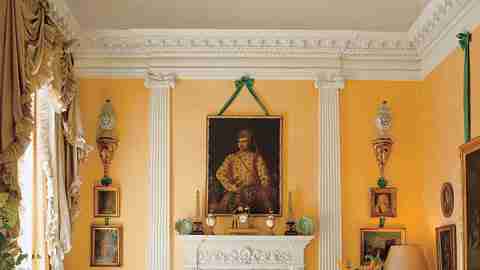December 26,2022
John Fowler
by David Stewart
John Fowler's entry into decoration occurred by chance. As a young man, he endured office jobs before escaping to a farm. Then, hearing of a position in the grand old London decorating firm Thornton Smith, he began in its paint studio "restoring"—or faking—Chinese wallpapers. From there he moved to head the new painted-furniture department at Peter Jones. Even then he had an original eye, creating smart, unusual rooms that mixed countrified Georgian furniture, French painted pieces, and the odd florid Victorian chair covered in voguish satin. From the start he was a genius at draperies.

In 1938 the decorator Sibyl Colefax invited Fowler to join her firm. As he began working for grander clients, his style became grander, too. The faded splendor of English country houses became his beau ideal, but it was his collaboration with an American client that would prove the crucial influence. Nancy Lancaster employed him to help with the decoration of her own rooms but became fascinated with decoration herself. At the end of World War II she bought the firm that became Colefax and Fowler from the retiring Colefax.
The working relationship between the two was always bracing. Lancaster's formidable aunt Nancy Astor called them "the unhappiest unmarried couple in England." It was the unique combination of their enthusiasms and talents—Fowler's knowledge, attention to detail and color sense and Lancaster's eye for scale and insistence on comfort—that led to the creation of their English country house look, a style that has lasted half a century.
In spite of crippling shortages of materials, which inspired Fowler to fashion superb draperies from dyed army blankets, the postwar years marked the beginning of their heyday. With the discovery of his own country house, the Hunting Lodge in Odiham, in the late 1940s, Fowler came closest to his aim of "humble elegance." "What I wanted here was something utterly unpretentious, very comfortable, with a veneer of elegance and informality." The pretty neo-Jacobean structure became, in the words of one later occupant, Fowler's "own personal Trianon." The country retreat, before that an earnest, spartan affair or something impossibly twee, would never be quite the same.
At the firm's Brook Street premises, Fowler's office was dominated by his "palette," a wall on which were pinned all his favorite samples and colors; most fabrics—such as the Bowood chintz—were named after the houses in which he had found the original documents. He formed a private language of color names such as "dead salmon" and "mouse's back"—to which Nancy Lancaster added the infamous "caca du dauphin" and "vomitesse de la reine."
Keith Irvine, Fowler's assistant in the 1950s, says he was "a brilliant taskmaster." But there were "fraught days, when, if John was being super-difficult, the best way to defuse the situation was to get him onto his pet subject, Marie Antoinette." As evidence of the jocular rumor that Fowler was her reincarnation, his staff would say that he "entered every room sideways, as if managing an invisible pannier dress."
In the 1960s and '70s Fowler was still engaged in major commercial projects but increasingly preferred to work with the National Trust. With his passion for old decoration (he always claimed to love "undisturbed houses") and his deep understanding of methods and materials, he had a key voice in the way conservation practice in historic interiors evolved in England.
By the time of his death in 1977, at the age of 71, John Fowler was recognized as the éminence grise of English decoration. One of the most touching of tributes was paid to his memory by his friend the duchess of Devonshire: "He was the prince of decorators," she said, "a scholar with a wonderful memory for whole rooms and the smallest details, and the best appreciator of beautiful things I have ever known."






